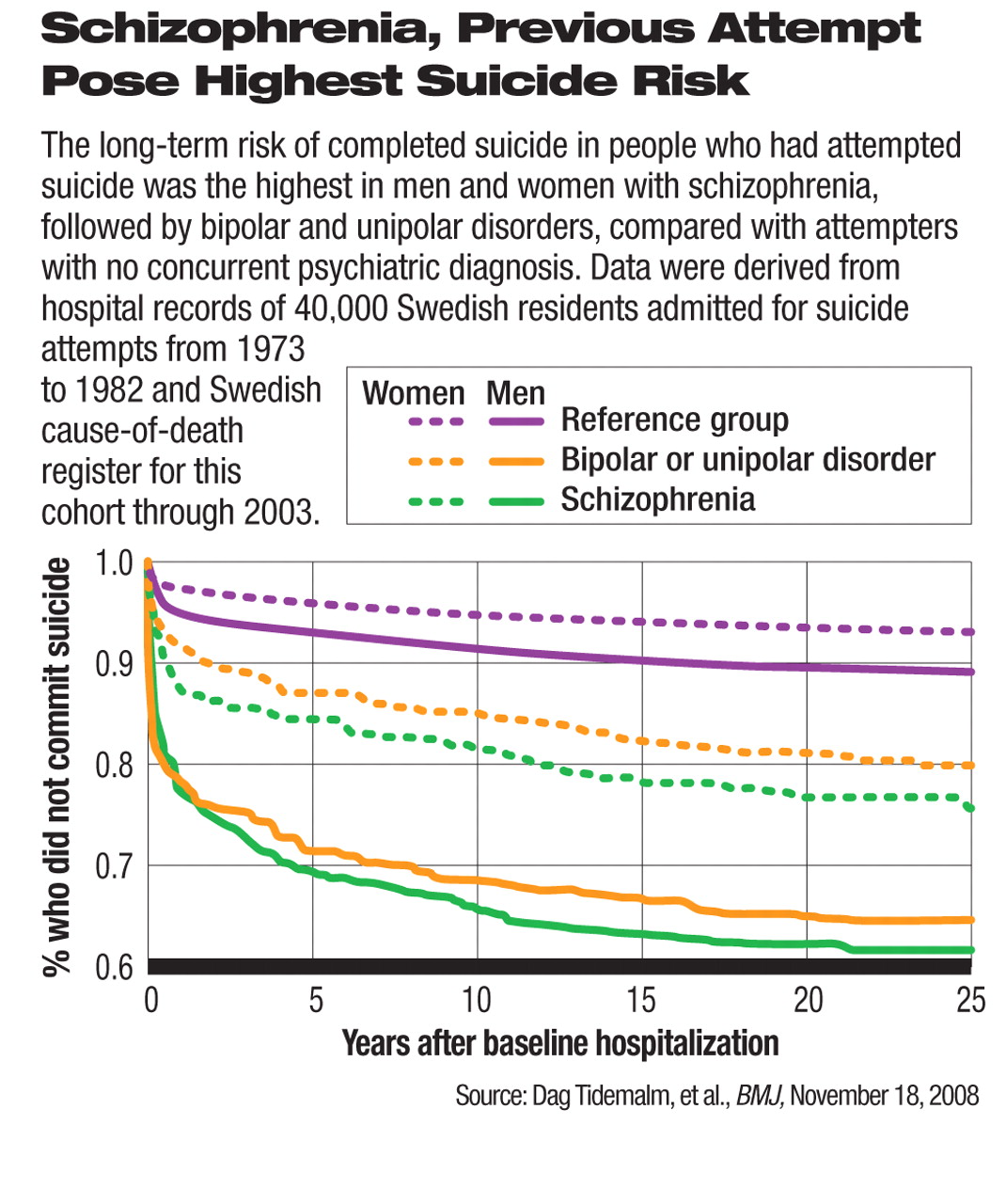It has been established that people who have attempted suicide are far more likely to complete it in future attempts than are those with no prior attempts. Now new research shows that coexisting schizophrenia or a mood disorder substantially increases the mortality in this population.
In a cohort of nearly 40,000 Swedish residents who had been hospitalized for attempted suicide between 1973 and 1982, researchers found that the likelihood of subsequent death from suicide among these individuals through 2003 was the highest in men and women with a concurrent diagnosis of schizophrenia (see graph). Compared with the suicide rates of the reference group, the suicide rates for men were 4.1 times higher and for women, 3.5 times higher. The reference group was composed of hospitalized attempters who had not received a psychiatric diagnosis within one year of the event.
The second highest risk group in this population was composed of those with a coexisting diagnosis of bipolar or unipolar disorder (with an International Classification of Disease [ICD] code of 296.1-296.9). Their risks of dying of suicide in the follow-up period were 3.5 times and 2.5 times the rates of the reference group in men and women, respectively.
A coexisting psychiatric disorder was defined as having a diagnosis from the following list concurrent with the hospitalization for suicide attempt or within one week after the attempt-related hospitalization: bipolar and unipolar disorders, other depressive disorders (ICD codes 296.0 and 300.4), schizophrenia, anxiety disorder, adjustment disorder or posttraumatic stress disorder (PTSD), alcohol abuse or dependence, drug abuse or dependence, and personality disorder. Those with other psychiatric diagnoses were excluded for the study cohort.
The most dangerous period appeared to be the first year after the hospitalization for suicide attempt, the study found. A large proportion of all the completed suicides in the overall follow-up period occurred within the first year of the attempt regardless of the psychiatric diagnosis, including the reference group.
Of the approximately 27,000 people in the reference group, about 11 percent of the men and 7 percent of the women eventually died of suicide in the 21 to 31 years of follow-up. In comparison, approximately 39 percent of the male attempters with schizophrenia eventually died of suicide in the same period, and more than half of these deaths occurred within one year after the attempt. Almost a quarter of the female attempters with schizophrenia died of suicide, more than half in the first year. A similar pattern was seen in attempters with bipolar and unipolar disorders.
Most other categories of psychiatric disorders were also associated with statistically significantly higher risks of eventual suicide during the follow-up period, except for adjustment disorder or PTSD in men and women and alcohol abuse or dependence in men.
Past studies documented a rate of completed suicide as high as 13 percent in people with past attempts, depending on the length of follow-up, the authors noted. Because it is difficult to identify people most likely to die from suicide within the general population, more aggressive interventions for those with past attempts and concurrent schizophrenia as well as mood disorders, while also considering the time frame after the previous attempt, can help mental health professionals better target high-risk patients and more effectively prevent suicide, they suggested.
The study authors used data on Swedish citizens in the national registry for hospital care in 1973-1982 and traced individuals in the national cause-of-death register, which contains information on more than 99 percent of Swedish residents, including deaths that occurred outside Sweden. The authors also adjusted for age, educational levels, and immigrant status as possible confounders in their analyses.
The study was published in BMJ online on November 18, 2008, and funded by the Stockholm County Council, the Karolinska Institute, which employed the authors, and the Swedish Prison and Probation Service.
An abstract of “Risk of Suicide After Suicide Attempt According to Coexisting Psychiatric Disorder: Swedish Cohort Study With Long Term Follow-Up” is posted at<www.bmj.com/cgi/content/abstract/337/nov18_3/a2205>.▪

